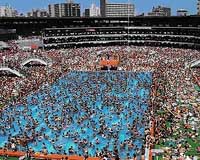| . |  |
. |
Lima (AFP) Dec 1, 2009 The Candoshi people in Peru's northern Amazon jungle are close to extinction from a hepatitis B infection that has gone unchecked since 2000, tribal leaders and health officials said Tuesday. "My people are suffering, we're in real danger of extinction," said Candoshi chief Venancio Ucama Simon. Standing next to a Candoshi woman suffering from hepatitis-induced cirrhosis who doctors said has only two years left to live, Apu, or chief, Ucama called on the government to declare a health emergency in his region. Speaking through an interpreter in Lima, Ucama accused Peru's health authorities of decades of inattention, letting hepatitis B and other diseases run unchecked, threatening to wipe out not only the Candoshi but other indigenous groups, including the Shapra, Awajun, Achuar and Huambisa. All the ethnic groups live in Peru's remote Daten del Maranon province, in northern Loreto department. "So far, 80 people have died from hepatitis B since 2000," said Gianina Lucana, a Candoshi nurse working for the World Wildlife Fund (WWF). She said the disease broke out in the 1990s, when Occidental Petroleum Corporation was granted exploration rights in her jungle region. "We had no cases of the disease before then," she added. But she noted the lack of reliable data on how many of her people have been infected with hepatitis B. The latest statistics, in 2000, mentioned 169 cases. "From that time to now, however, things have deteriorated badly. There have been lots of deaths apparently from hepatitis B, but it's been impossible to determine exactly how many because of lack of medical attention," the nurse said. Ucama complained that federal and local health authorities were trading blame for the plight of the Candoshi and citing the high cost of hepatitis B treatment as a reason for the inattention. "Does that mean that because it's very expensive they're going to let our people die out?" asked Lucana. The Candoshi population is currently estimated to number 2,400. It is highly praised for its ancestral conservationist culture, which the WWF said has helped restore Amazon wildlife around lake Rimachi, Peru's largest in the region. Share This Article With Planet Earth
Related Links All About Human Beings and How We Got To Be Here
 Once taboo, population enters climate debate
Once taboo, population enters climate debateParis (AFP) Nov 30, 2009 For decades, debate over whether to limit global population growth was stifled or ignored, branded as immoral and a return to heartless Malthusian logic. But the potential impact on climate change of a planet teaming with up to ten billion souls has again forced the issue into the open ahead of the December 7-18 UN climate conference in Copenhagen. In a sign of change, the UN Population ... read more |
|
| The content herein, unless otherwise known to be public domain, are Copyright 1995-2009 - SpaceDaily. AFP and UPI Wire Stories are copyright Agence France-Presse and United Press International. ESA Portal Reports are copyright European Space Agency. All NASA sourced material is public domain. Additional copyrights may apply in whole or part to other bona fide parties. Advertising does not imply endorsement,agreement or approval of any opinions, statements or information provided by SpaceDaily on any Web page published or hosted by SpaceDaily. Privacy Statement |